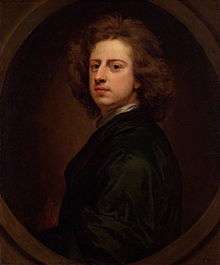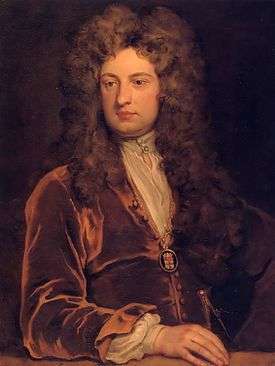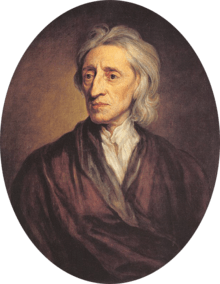Godfrey Kneller
| Sir Godfrey Kneller, Bt | |
|---|---|
 Sir Godfrey Kneller - Self portrait | |
| Born |
Gottfried Kniller 8 August 1646 Lübeck, Holy Roman Empire |
| Died |
19 October 1723 (aged 77) London, Great Britain |
| Residence | London, England |
| Nationality | German, later British |
| Occupation | Painter |
| Known for | Leading portrait painter of England |
Sir Godfrey Kneller, 1st Baronet (born Gottfried Kniller; 8 August 1646 – 19 October 1723) was the leading portrait painter in England during the late 17th and early 18th centuries, and was court painter to English and British monarchs from Charles II to George I. His major works include The Chinese Convert (1687; Royal Collection, London); a series of four portraits of Isaac Newton painted at various junctures of the latter's life; a series of ten reigning European monarchs, including King Louis XIV of France; over 40 "Kit-cat portraits" of members of the Kit-Cat Club; and ten "beauties" of the court of William III, to match a similar series of ten beauties of the court of Charles II painted by his predecessor as court painter, Sir Peter Lely.
Early life



Kneller was born Gottfried Kniller in the Free City of Lübeck, the son of Zacharias Kniller, a portrait painter.[1] Kneller studied in Leiden, but became a pupil of Ferdinand Bol and Rembrandt Harmenszoon van Rijn in Amsterdam. He then traveled with his brother John Zacharias Kneller, who was an ornamental painter, to Rome and Venice in the early 1670s, painting historical subjects and portraits in the studio of Carlo Maratti, and later moved to Hamburg.
Career
The brothers came to England in 1676,[2] and won the patronage of the Duke of Monmouth. He was introduced to, and painted a portrait of, Charles II. In England, Kneller concentrated almost entirely on portraiture. In the spirit ofenterprise, he founded a studio which churned out portraits on an almost industrial scale, relying on a brief sketch of the face with details added to a formulaic model, aided by the fashion for gentlemen to wear full wigs. His portraits set a pattern that was followed until William Hogarth and Joshua Reynolds.
Nevertheless, he established himself as a leading portrait artist in England. When Sir Peter Lely died in 1680, Kneller was appointed Principal Painter to the Crown by Charles II. In the 1690s, Kneller painted the Hampton Court Beauties depicting the most glamorous ladies-in-waiting of the Royal Court for which he received his knighthood from William III. He produced a series of "Kit-cat" portraits of 48 leading politicians and men of letters, members of the Kit-Cat Club. Created a baronet by King George I on 24 May 1715,[1] he was also head of the Kneller Academy of Painting and Drawing 1711-1716 in Great Queen Street, London, which counted such artists as Thomas Gibson amongst its founding directors. His paintings were praised by Whig luminaries such as John Dryden, Joseph Addison,[3] Richard Steele, and Alexander Pope.
On the landing in Horsham Museum hang works of art from the Museum's extensive painting collection, featuring a large 18th-century portrait of Charles Eversfield and his wife, of Denne Park House.[4] In the painting Eversfield is giving his wife some violets which signifies fidelity, love and honesty. It is likely that the picture was cut down at some time as it was unusual to stop just below the knee. It may have been painted by more than one person: someone who specialised in clothing, another in drapes, and so on, with perhaps the great court painter Sir Godfrey Kneller painting the heads, for it was the portraits that gave the sitters their identity, everything else is rather formulaic.
Personal life
He married a widow, Susanna Grave, on 23 January 1704 at St Bride's Church, London.[1] She was the daughter of the Reverend John Cawley, Archdeacon of Lincoln and Rector of Henley-on-Thames, and the granddaughter of regicide William Cawley.[1] The couple had no children.
Death
Kneller died of fever in 1723 at Great Queen Street and his remains were interred at Twickenham. He had been a churchwarden at St Mary's, Twickenham when the 14th-century nave collapsed in 1713 and was active in the plans for the church's reconstruction by John James.[5] His widow was buried at Twickenham on 11 December 1729.[1]
Legacy
A memorial was erected in Westminster Abbey.[1] Kneller's will gave a pension of £100 a year to his assistant Edward Byng and entrusted Byng with seeing that all unfinished work was completed. Byng also inherited the drawings in Kneller's studio.[6] Kneller and his wife had no children together.[1] Most of his fortune was inherited by his grandson, Godfrey Kneller Huckle, who was the son of Agnes Huckle,[1] Kneller's illegitimate daughter by Mrs Voss,[7] and who took his grandfather's surname (Kneller)[8] as a condition of his inheritance.
The site of the house Kneller built in 1709 in Whitton, near Twickenham, became occupied by the mid-19th century Kneller Hall, home of the Royal Military School of Music.[1]
Character
"As to thinking better or worse of mankind from experience, some cunning people will not be satisfied unless they have put men to the test, as they think. There is a very good story told of Sir Godfrey Kneller, in his character of a Justice of the peace. A gentleman brought his servant before him, upon an accusation of having stolen some money from him; but it having come out that he had laid it purposely in the servant's way, in order to try his honesty, Sir Godfrey sent the master to prison."[9]
Works
In his hometown Lübeck there are works to be seen in the St. Annen Museum and in Saint Catherine Church. His former works at St. Mary's Church were destroyed by the Bombing of Lübeck 1942. A large oil portrait (84" x 55") of James VII of Scotland (King James II of England) hangs on the main staircase of private members' Club, The Caledonian Club, in Belgravia, London.
See also
References
- Notes
- 1 2 3 4 5 6 7 8 9 Cokayne, George Edward (1906) Complete Baronetage. Volume V. Exeter: W. Pollard & Co. LCCN 06-23564. pp. 27–28
- ↑ Stewart, J. Douglas (2004). "Kneller, Sir Godfrey , baronet (1646–1723)". Oxford Dict Biography. Oxford University Press. doi:10.1093/ref:odnb/15710. Retrieved 2012-05-23. (subscription or UK public library membership required)
- ↑ See e.g. Addison's poem "To Sir GODFREY KNELLER, on his PICTURE of the KING"
- ↑ Horsham Museum Guidebook. Horsham District Council. May 2010.
- ↑ Memorials of Twickenham Parochial and Topographical, R.S. Cobbett, Smith, Elder & Co., London, 1872
- ↑ Edward Byng at britishmuseum.org, accessed 24 November 2012
- ↑ Miss Agnes Voss, daughter of Mrs Voss and Sir Godfrey Kneller, afterwards Mrs Huckle at the Royal Collection.
- ↑ Deed Poll Office: Private Act of Parliament 1730 (4 Geo. 2). c. 32
- ↑ Boswell, James (1791). The Life of Samuel Johnson, LL.D.: Comprehending an Account of His Studies and Numerous Works, in Chronological Order; a Series of His Epistolary Correspondence and Conversations with Many Eminent Persons; and Various Original Pieces of His Composition, Never Before Published. The Whole Exhibiting a View of Literature and Literary Men in Great-Britain, for Near Half a Century, During which He Flourished. II (1 ed.). London: Printed by Henry Baldwin for Charles Dilly. p. 194. Retrieved 25 June 2016 – via Google Books.
- Sources
- (Dutch) Godfried & Johan Zacharias Kneller biography in De groote schouburgh der Nederlantsche konstschilders en schilderessen (1718) by Arnold Houbraken, courtesy of the Digital library for Dutch literature
External links
| Wikimedia Commons has media related to Godfrey Kneller. |
- 825 Paintings by Godfrey Kneller at the Art UK site
| Wikisource has the text of a 1920 Encyclopedia Americana article about Godfrey Kneller. |
- King Charles II (1685) at the Walker Art Gallery, Liverpool
- Artcyclopedia: Sir Godfrey Kneller
- Biography
- Godfrey Kneller at PubHist
- Portraits by Kneller at the National Portrait Gallery
- Self-portrait at the National Portrait Gallery
- Horsham Museum
| Court offices | ||
|---|---|---|
| Preceded by Sir Peter Lely |
Principal Painter in Ordinary to the King 1680-1723 |
Succeeded by William Kent |
| Baronetage of Great Britain | ||
| New creation | Baronet (of Whitton) 1715–1723 |
Extinct |